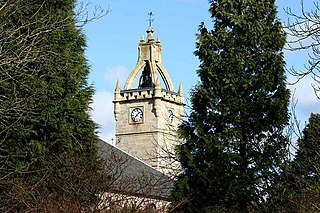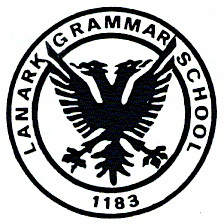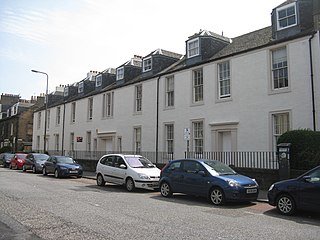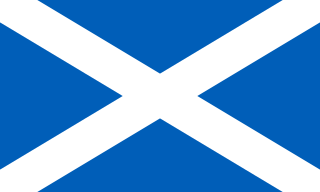
East Kilbride is the largest town in South Lanarkshire in Scotland and the country's 6th largest settlement. It was also designated Scotland's first new town on 6 May 1947. The area lies on a raised plateau to the south of the Cathkin Braes, about 8 miles (13 km) southeast of Glasgow and close to the boundary with East Renfrewshire. East Kilbride is twinned with the Danish city Ballerup.

New Lanark is a village on the River Clyde, approximately 1.4 miles from Lanark, in Lanarkshire, and some 25 miles (40 km) southeast of Glasgow, Scotland. It was founded in 1786 by David Dale, who built cotton mills and housing for the mill workers. Dale built the mills there in a brief partnership with the English inventor and entrepreneur Richard Arkwright to take advantage of the water power provided by the only waterfalls on the River Clyde. Under the ownership of a partnership that included Dale's son-in-law, Robert Owen, a Welsh philanthropist and social reformer, New Lanark became a successful business and an early example of a planned settlement and so an important milestone in the historical development of urban planning.
Third Lanark Athletic Club was a professional Scottish football club based in Glasgow. Founded in 1872 as an offshoot of the 3rd Lanarkshire Rifle Volunteers, they were founder members of the Scottish Football Association (SFA) in 1872 and the Scottish Football League (SFL) in 1890. They played in the top division of the SFL for the majority of their existence, and were league champions in 1903–04. They also won the Scottish Cup twice, in 1889 and 1905. Third Lanark went out of business in 1967 as a result of mismanagement, six years after having finished in third place in the SFL. Their former ground, Cathkin Park in Crosshill, is still partially standing and used for minor football.

The Falls of Clyde is the collective name of four linn on the River Clyde near New Lanark, South Lanarkshire, Scotland. The Falls of Clyde comprise the upper falls of Bonnington Linn, Corra Linn, Dundaff Linn, and the lower falls of Stonebyres Linn. Corra Linn is the highest, with a fall of 26 metres (84 ft). Bonnington Linn, Corra Linn and Dundaff Linn are above New Lanark and located within the Falls of Clyde Reserve managed by the Scottish Wildlife Trust, a national nature conservation charity. Stonebyres Linn is located several miles downstream from the reserve and New Lanark.

Lanark Grammar School is a secondary school in Lanark, Scotland. It was founded in 1183, and celebrated its octocentenary in 1983, including a visit by The Princess Anne. The school draws its pupils from the town of Lanark and many villages in the local area, including Douglas, Carstairs, Forth

Auchinloch is a village in North Lanarkshire, near Lenzie in Scotland. In previous years it was in the Parish of Cadder and, until recently, Strathkelvin District. The village's name - "Field of the Loch" - derives from its proximity to a small loch called the Gadloch. The area was sometimes known as the Loch Lands.

Kilncadzow is a small village in rural South Lanarkshire, lying roughly 5 km north of Lanark and 5 km east-southeast of Carluke, on the A721 road.

The 1873–74 Scottish Cup – officially the Scottish Football Association Challenge Cup – was the first season of Scotland's most prestigious football knockout competition. A total of 16 teams from the west of Scotland entered the competition, however only 14 would play a match after two withdrawals. The competition began on 18 October 1873 and concluded with the final on 21 March 1874. The inaugural cup was won by Queen's Park who defeated fellow Glasgow club Clydesdale 2–0 in the final.
Andrew Douglas "Drew" Busby is a Scottish former footballer who played for Third Lanark, Airdrieonians, Hearts, Toronto Blizzard and Morton. Busby also served Queen of the South as their player-manager.

The 1874–75 Scottish Cup was the second season of Scotland's most prestigious football knockout competition. Teams from Edinburgh, Renfrewshire and Lanarkshire entered the competition for the first time and with 12 new teams entering the competition, a total of 25 were included in the first round draw. The competition began on 10 October 1874 and concluded with the final on 10 April 1875. The cup was won for the second time by Queen's Park who defeated Dunbartonshire club Renton 3–0 in the final.

Blackheath drill hall is a military installation at Blackheath in London.

The Gilmore Place drill hall was a military installation in Edinburgh.

The Victoria Road drill hall is a former military installation in Glasgow.

The Hunter Street drill hall is a military installation in Kirkcaldy, Scotland.

The High West Street drill hall is a former military installation in Dorchester, Dorset. It is a Grade II listed building.

The Church Street drill hall is a military installation in Brighton. It is a Grade II listed building.

The Wellington Square drill hall was a military installation in Ayr.



















